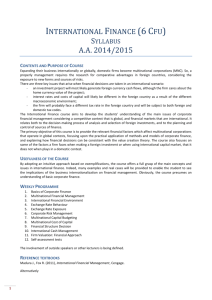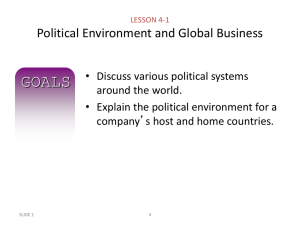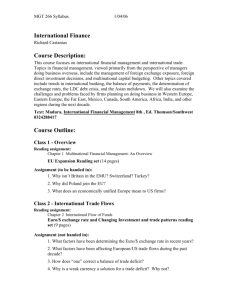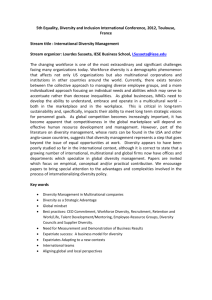oaf 322 international finance - The Open University of Tanzania
advertisement
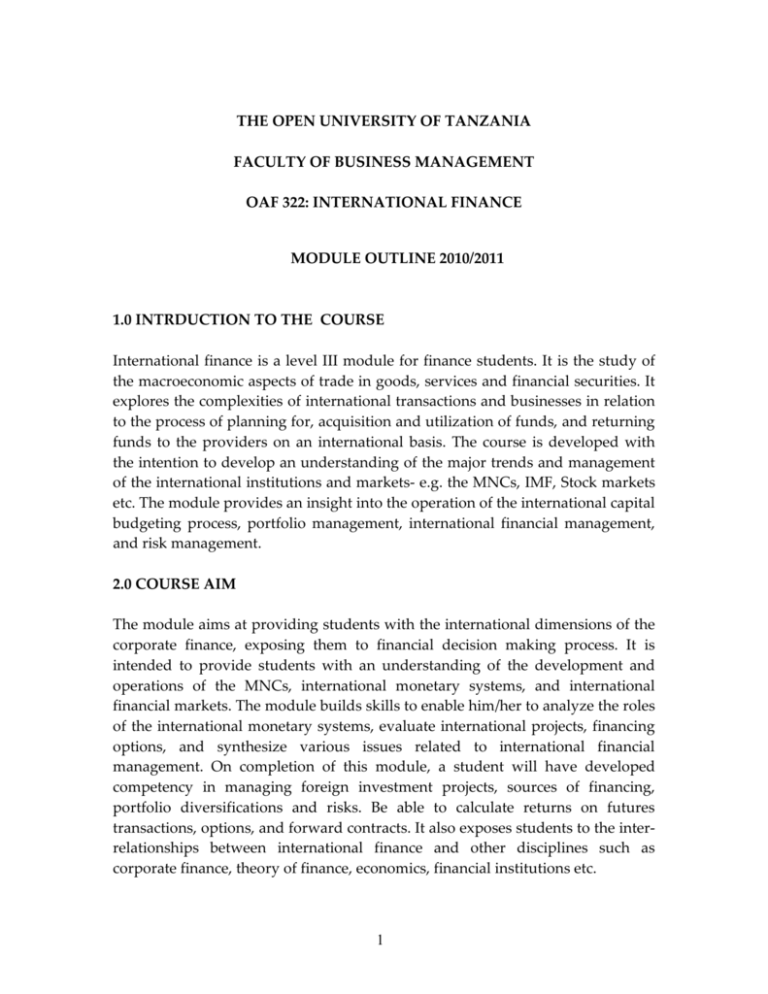
THE OPEN UNIVERSITY OF TANZANIA FACULTY OF BUSINESS MANAGEMENT OAF 322: INTERNATIONAL FINANCE MODULE OUTLINE 2010/2011 1.0 INTRDUCTION TO THE COURSE International finance is a level III module for finance students. It is the study of the macroeconomic aspects of trade in goods, services and financial securities. It explores the complexities of international transactions and businesses in relation to the process of planning for, acquisition and utilization of funds, and returning funds to the providers on an international basis. The course is developed with the intention to develop an understanding of the major trends and management of the international institutions and markets- e.g. the MNCs, IMF, Stock markets etc. The module provides an insight into the operation of the international capital budgeting process, portfolio management, international financial management, and risk management. 2.0 COURSE AIM The module aims at providing students with the international dimensions of the corporate finance, exposing them to financial decision making process. It is intended to provide students with an understanding of the development and operations of the MNCs, international monetary systems, and international financial markets. The module builds skills to enable him/her to analyze the roles of the international monetary systems, evaluate international projects, financing options, and synthesize various issues related to international financial management. On completion of this module, a student will have developed competency in managing foreign investment projects, sources of financing, portfolio diversifications and risks. Be able to calculate returns on futures transactions, options, and forward contracts. It also exposes students to the interrelationships between international finance and other disciplines such as corporate finance, theory of finance, economics, financial institutions etc. 1 3.0 COURSE LEARNING OUTCOMES After completion of this course, you will be able to: • Identify the underlying factors that contribute to the process of globalization and the expansion of the multinational companies. • Describe the foreign exchange markets operations and its applications to international business and apply the necessary techniques to hedge and protect international investments • Explain the concepts of international parity relations, such as interest rate parity, purchasing power parity, and the international fisher effects and how they are used to determine the interest rates • Identify the multinational sources of capital and investment appraisal techniques in an international perspective. • Apply international financial techniques to assist companies to diversify their international operations. • Measure and manage foreign exchange risk exposure from the point of view of multinational corporations. 4.0 COURSE PRE-REQUISITES The course builds from the assumption of students having basic knowledge of finance, accounting, and macroeconomics. Students should understand the concepts of discount rate, risk premium, expected return and risk, and CAPM, prior to enroll in this course. Possession of critical analytical skills as well as reasonable quantitative skills such as algebra and statistics are required. The student will need either a calculator or financial tables. 2 5.0 COURSE CONTENT 5.1 Lecture 1: Overview of Multinational Corporation and international finance 5.1.1 Introduction The development in modern communications and transportation technologies has accelerated the evolution and expansion of multinational corporations (MNCs). These corporations engage in production and selling goods or services in more than one country. International finance is concerned with the financial transactions of MNCs across borders of nations. This lecture, therefore, provides a basis for the study of international finance by looking at the meaning, importance and characteristics of international business. It also examines the factors for evolution and expansion of MNCs. Lastly; it discusses the functions and challenges of an international finance manager. 5.1.2 Key Learning Objectives At the end of this lecture you will be able to: • • • Explain the meaning and importance of International Business Distinguish between domestic and international business Discuss the factors for evolution and expansion of MNCs • Define international finance and explain the principles of global finance • Describe the function of the International Financial Manager • Discuss the challenges facing an international financial manager 5.1 Content • • • • • Meaning and nature of international business Evolution and expansion of the Multinational Corporation (MNC) Roles of MNCs in the socio- economic environment International finance management Functions of the international financial manager 3 5.2 Lecture 2: 5.2.1 International institutions monetary agreement and Introduction This topic looks at the development of International monetary agreement and Institutions. It starts by providing a historical background of the International monetary system which is an essential element for the study of international finance. It then looks at the different exchange rate regimes- flexible, fixed, and managed regimes. 5.2.2 Key Learning Objectives Upon completing this lecture, you will be able to: 5.2.3 • Define and explain the history of the international monetary system. • Discuss the functions and role of the International Monetary Fund • Identify and discuss the advantages and disadvantages of each of the exchange rate regime Content • • • Background to the International Monetary System - The Gold Standard - The Bretton Woods Agreement The International Monetary Fund (IMF) Exchange Rate Regimes: - Flexible Regime - Fixed Regime - Managed Regime - Central Bank Interventions 4 5.3 Lecture 3: The balance of payments 5.3.1 Introduction The Balance of Payment is one of the most important economic indicators for policy makers in an open economy. This topic presents the financial and real linkage between the domestic and the rest of the world economies and their economic effects to respective countries. 5.3.2 Key Learning Objectives Upon completing this topic, a student should be able to: 5.3.3 • Explain the basic forces underlying the flow of goods, services and capital between countries. • Describe the types of balance of payment accounts and be able to collect report and present the balance of payments accounts. • Understand the concepts of surplus and deficits balances and explain their effect in the economy • Identify and discuss ways to cope with govern ment budgets deficits. Content • • • • Meaning and uses of the balance of payment International flow of goods, services and capital The Balance of Payment Accounts Government budget deficits 5 5.4 Lecture 4: The foreign exchange market 5.4.1 Introduction The foreign exchange market is the largest and most liquid financial market in the world. Traders include large banks, central banks, currency speculators, corporations, governments, and other financial institutions. The average daily volume in the global foreign exchange and related markets is continuously growing. The primary purpose of the foreign exchange market is to assist international trade and investment, by allowing businesses to convert one currency to another currency. This topic discusses the organization of the foreign exchange market- including the spot market, the forward market, and the links between the spot and forward market. 5.4.2 Key Learning Objectives After completing this lecture, you should be able to: Explain the nature and characteristics of the foreign exchange market Identify the participants of the foreign exchange market Distinguish between spot and forward markets Solve problems related to foreign exchange currencies and arbitrages. 5.4.3 Content • • • • • Meaning, Tiers, and Dimensions of Foreign Exchange Market Participants in the Foreign Exchange Market Characteristics of Foreign Exchange Markets The Spot Market - Spot Quotations - Transaction Costs and the Bid- Ask Spread - Cross- Rates - Currency Arbitrage The Forward Market - Fixed Quotations - Premium and Discount in Forward Market - Forward Cross exchange Rates 6 - 5.5 Forward Rate Vs Future Rate. Lecture 5: International parity conditions 5.5.1 Introduction In the foregoing lecture, we looked at the foreign exchange market. Among other issues, exchange rates were discusses. This lecture introduces you to the earliest and simplest models (theory) of exchange rate determination- the purchasing power parity (PPP). The lecture will provide you with the parity relationships, their use, and measurements in PPP 5.5.2 Key Learning Objectives After completing this lecture, you should be able to: • • • Describe the law of one price Define purchasing power parity, fisher effect, and the international fisher effect Apply this theory (relationship) to solve problems related to spot rate, inflation rate and interest rate in different currencies. 5.5.3 Content • • • • The law of one price Purchasing Power parity (PPP) Fisher Effect (FE) International Fisher Effect (IFE) 5.6 Lecture 6: Foreign exchange exposures (Risks) 5.6.1 Introduction In the course of their operations, companies are affected by the fluctuations in exchange rates. What are these exposures and their associated risks? How do firms then cope with currency changes? This chapter identifies the different types of exposures (transaction, translation and operating) and discusses the measures used to cope with the associated risks. 7 5.6.2 Objectives After completing this lecture, you should be able to: • • • Define and identify different types of foreign exchange risks Measure foreign exchange risks Manage foreign exchange risks 5.6.3 Content • • • • Currency Exposure and Risks- Overview Transaction Exposure: Translation Exposure Operating Exposure 5.7 Lecture 7: Derivative markets and Instruments 5.7.1 Introduction Derivative markets are markets for financial investments that derive their value from the underlying financial assets. In this module, we will deal with three types of derivative markets - futures, swaps and options markets. We will discuss the characteristics and hedging strategies of these markets. Distinguishing features between futures and forward contracts will be explained at the end of the lecture. 5.7.2 Objectives After completing this lecture, you should be able to: • Define and explain the characteristics of futures, swaps, and option currency • Describe the alternative hedging and speculative mechanisms offered by these derivatives. • Distinguish between futures and forward contracts. 5.7.3 Content • • • • • Meaning, types and characteristics of derivative markets Currency and interest rate futures Currency and Interest rate swaps Currency and Interest rate options Futures contracts Vs forward contracts 8 5.8 Lecture 8: Foreign Direct Investment (FDI) 5.8.1 Introduction In lecture one we saw that the rise of the multinational is influenced by a variety of market imperfections such as government regulations and control, contracting, transactions, and coordinating costs. The existence of imperfect markets explains for the firms to opt for foreign direct investment. In this lecture you will be introduced to the trend and motives of FDI, the types of market imperfection, and the advantages and disadvantages of FDI to a host country. Finally, the lecture will discuss the impact of FDI to third word countries. 5.8.2 Objectives After completing this lecture, you should be able to: • Define and discuss the current trend on FDI • Discuss various types of market imperfection and discuss how they lead firm to become multinational • Discuss the advantages and disadvantages of FDI to a host country 5.8.3 Content • • • • Overview of FDI Market imperfection and Multinationals Advantages and Disadvantages of FDI to Host Countries FDI in Less Developed Countries 5.9 Lecture 9: International Capital Budgeting Decisions 5.9.1 Introduction One of the distinguishing features between a domestic and foreign firm is the fact that evaluation and analysis of foreign investment is complicated by a number of problems such as changes in exchange rates and inflation, foreign tax regulations, differences between project and company cash flows, etc. This 9 lecture intends to provide you with an understanding and skills on how to adjust cash flows of the multinational firm for capital budgeting. 5.9.2 Objectives After completing this lecture, you should be able to: • Recall the basic capital budgeting techniques • Explain how cash flows can be treated/adjusted in foreign projects • Use the net present value technique to appraise projects in foreign investments 5.9.3 Content • • Capital Budgeting Techniques- Overview Foreign Project Appraisal - Domestic Vs Foreign Perspectives - Parent Vs Subsidiary Perspectives - NPV Approach to International Capital Budgeting 5.10 Lecture 10: International Portfolio management 5.10.1 Introduction The basic rule of portfolio diversification states that: The broader the diversification, the more stable the returns and the more diffuse the risks. Investors know that in order to reduce the level of risks, one has to diversify investment across industries. And that through international diversification, one reduce further the variability of their returns. The purpose of this lecture is to provide you with the basic knowledge on portfolio management. It explains on the benefits of portfolio investments and highlights the elements of return on foreign investment. Further, it introduces you on how to calculate returns on equity and bonds. 5.10.2 Objectives After completing this lecture, you should be able to: • • • Define and explain the benefits of portfolio investment Discus the elements of return on a foreign investment Calculate total returns on a foreign investment 10 5.10.3 Content • • • Meaning advantages of portfolio investment Measuring total return from foreign investing Investing equity and bond 5.11 Lecture 11: International Financing Decisions 5.11.1Introduction In lecture 9 we saw how a firm can make decisions on investments. This lecture intends to provide you with the techniques which will enable international financial managers to make decisions on where and how to get funds for investments. This kind of decision is influenced by a number of factors. One of such factors is the cost of capital- which is dealt with in this lecture. The lecture will cover the sources of capital (equity and debt), cost of capital (with emphasis on the weighted average cost of capital), and discount rates. 5.11.2 Objectives After completing this lecture, you should be able to: • • Identify the sources of both equity and debt capital for foreign projects Calculate the cost of capital for foreign projects 5.11.3 Content • • International source of capital The Cost of Capital for Foreign Investments - The Weighted Average Cost of Capital (WACC) - Discount Rates for Foreign Investments 11 5.12 Lecture 12: International financial markets 5.12.1 Introduction The expansion and growth of multinational activities has necessitated the use of a wide range of external source of funds. Thus more firms are going directly to the financial markets for funds. In This lecture will provide you with the types and operations of the international financial markets. It will look at the international money and capital markets- types, securities, and operations. 5.12.2Objectives After completing this lecture, you should be able to: • • • • Distinguish between domestic and foreign financing Explain the payment terms in foreign trade Identify the different types markets and securities in the international money and capital markets. Discuss the development of the DSE in cross listing of companies. 5.12.3 Content • • The International Money Market - Internal Vs External Financing- Overview - The Need for Foreign Currency - The Euro currency Markets The International Capital Market - • National Capital Markets as International Financial Centers Foreign Bonds and Euro Bonds International Equity Markets Cross Listing The Dar es Salaam Stock Exchange (DSE) 12 5.13 Lecture 13: Multinational working capital management 5.13.1 Introduction The purpose of this lecture is to introduce you to elementary principles and management of working capital of the multinational firm. It looks at the different types of short term financing objectives and options. Financing foreign trade and current asset management is dealt. The lecture also deals with some types of documentations, settlement terms, and financing techniques as applied in international trade perspectives. Government sources of export financing are also considered. 5.13.2 Objectives After completing this lecture, you should be able to: • Explain objectives that can guide a firm in deciding where and in which currencies to borrow • Identify the various short- term financing options • Discuss how cash, accounts receivable and inventories of a multinational firm can be managed. • Identify the payment terms, settlement terms, and financing techniques as used in international finance. • Discuss the various government sources of export financing. 5.13.3 Content • • • Managing short- term financing - Short-term financing objectives - Short-term financing options Current Asset Management - International cash management - Accounts receivable management - Inventory management Financing foreign trade Payment terms in foreign trade 13 - Documentations Settlement terms Financing techniques Counter trade Government sources of export financing 5.14 Lecture 14: International tax management Introduction Taxes affect most of the financial decisions in an international context. It has an impact on the management of exchange risks, determining the cost of capital, capital structure, etc. In this lecture, you will be introduced to the concept of international taxation. It will cover meaning of international taxation, decisions for international tax planning, and effects of international taxation. 5.14.1 Objectives At the end of this lecture, you should be able to: • • • Define international taxation Define and discuss the effects of international taxation Discuss tax incentives for foreign investors in Tanzania 5.14.3 Content • • • Meaning of international taxation Effects of international taxation Tax incentives for foreign trade 5.15 Lecture 15: Political risks in international trade 5.15.1Introduction Quotas, currency controls, and change in tax laws are some of the more visible forms of political risks. It therefore requires for foreign investors to understand the political environment of the host country. This lecture therefore provides a 14 framework aimed to facilitate an assessment of political risks for corporate decision making. It looks at the meaning and general concepts, approaches, and effects of political risks. It concludes by identifying the ways of managing political risks. 5.15.2 Objectives At the end of this lecture, you should be able to: • Define and explain the concepts of political risks • Describe the approaches for measuring political risks • Discuss the effects of political risks on multinational foreign trade • Identify and discuss the ways for managing political risks 5.15.3 Content • • • • General Concept and Theory of Political Risk Measuring political risks Effects of Political Risks on Multinational Foreign Trade Management of Political Risks Assessment Strategy Compulsory Student Progress Portfolio, timed test and final examination Assessment Criteria One timed Test 30% Final Examination 70% Total 100% Pass mark shall be 40% 15 Recommended Readings Gallagher, T. (2003) Financial management and mastering finance. 3rd edition: Prentice Hall. Lessard D. R. (1984) International financial management. 2nd edition: John Wiley and Sons Rivera, F. (1994) International finance and open economy macroeconomics. 2nd edition: Prentice Hall. *Shapiro A. C. (2002) Multinational financial management. 4th edition. New Delhi Prentice- Hall NB: *Recommended main text 16
